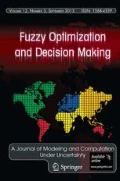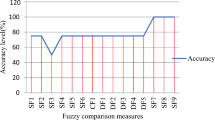Abstract
Clustering algorithms divide up a dataset into a set of classes/clusters, where similar data objects are assigned to the same cluster. When the boundary between clusters is ill defined, which yields situations where the same data object belongs to more than one class, the notion of fuzzy clustering becomes relevant. In this course, each datum belongs to a given class with some membership grade, between 0 and 1. The most prominent fuzzy clustering algorithm is the fuzzy c-means introduced by Bezdek (Pattern recognition with fuzzy objective function algorithms, 1981), a fuzzification of the k-means or ISODATA algorithm. On the other hand, several research issues have been raised regarding both the objective function to be minimized and the optimization constraints, which help to identify proper cluster shape (Jain et al., ACM Computing Survey 31(3):264–323, 1999). This paper addresses the issue of clustering by evaluating the distance of fuzzy sets in a feature space. Especially, the fuzzy clustering optimization problem is reformulated when the distance is rather given in terms of divergence distance, which builds a bridge to the notion of probabilistic distance. This leads to a modified fuzzy clustering, which implicitly involves the variance–covariance of input terms. The solution of the underlying optimization problem in terms of optimal solution is determined while the existence and uniqueness of the solution are demonstrated. The performances of the algorithm are assessed through two numerical applications. The former involves clustering of Gaussian membership functions and the latter tackles the well-known Iris dataset. Comparisons with standard fuzzy c-means (FCM) are evaluated and discussed.
Similar content being viewed by others
References
Abrantes A.J. and Marques J.S. (1996). A class of constrained clustering algorithms for object boundary extraction. IEEE Transactions of Image Processing 5: 1507–1521
Anderson E. (1935). The iris of the Gaspe peninsula. Bulletin American Society 59: 2–5
Anderberg M.R. (1973). Cluster analysis for applications. Academic Press, Inc., New York
Bezdek J.C. (1980). A convergence theorem for the fuzzy ISODATA clustering algorithms. IEEE Transactions on Pattern Analysis and Machine Intelligence 2: 1–8
Bezdek J.C. (1981). Pattern recognition with fuzzy objective function algorithms. Plenum, New York
Bezdek J.C., Coray C. and Gunderson R. (1981). Detection and characterization of cluster structure. SIAM Journal of Applied Mathematics, Part 1 40(2): 339–357
Bezdek J.C., Hathaway R.J., Howard R.E., Wilson C.A. and Windham M.P. (1987). Local convergence analysis of a grouped variable version of coordinate descent. Journal of Optimal Theory & Applications 54(3): 471–477
Dave R.N. (1990). Fuzzy shell-clustering and applications to circle detection in digital images. Journal of General Systems 16: 343–355
Dave R.N. and Krishnapuram R. (1997). Robustering methods: A unified view. IEEE Transactions of Fuzzy Sets and Systems 5(2): 270–293
Dun J.C. (1973). A Fuzzy relative of the ISODATA process and its use in detecting compact well separated clusters. Journal of Cybernetics 3(3): 32–57
Gath I. and Geva A.B. (1989). Unsupervised optimal fuzzy clustering. IEEE Transactions on Pattern Analysis and Machine Intelligence 11(7): 773–777
Gowda K.C. and Krishna G. (1977). Agglomerative clustering using the concept of mutual nearest neighborhood. Pattern Recognition 10: 105–112
Gowda K.C. and Diday E. (1992). Symbolic clustering using a new dissimilarity measure. IEEE Transactions on Systems, Man and Cybernetics 22: 368–378
Gustafson, D. E., & Kessel, W. C. (1979). Fuzzy clustering with fuzzy covariance matrix. In Proceedings of IEEE CDC. San Diego, CA, pp. 761–766.
Ichino M. and Yaguchi H. (1994). Generalized Minkowski metrics for mixed feature-type data analysis. IEEE Transaction on Systems Man Cybernetics 24: 698–708
Jain A.K., Murty M.N. and Flynn P.J. (1999). Data clustering: A review. ACM Computing Surveys 31(3): 264–323
Jarvis R.A. and Patrick E.A. (1973). Clustering using a similarity method based on shared near neighbors. IEEE Transactions on Computations C-22(8): 1025–1034
Krusinska E. (1987). A valuation of state of object based on weighted Mahalanobis distance. Pattern Recognition 20: 413–418
Kullback, S. (1968). Information theory and statistics (2nd ed.). Dover.
Looney C.G. (2002). Interactive clustering and merging with a new fuzzy expected value. Pattern Recognition 35: 2413–2423
Mao J. and Jain A.K. (1996). A self-organizing network for hyperellipsoidal clustering (HEC). IEEE Transactions on Neural Networks 7: 16–29
Nefti, S., & Oussalah, M. (2004). Probabilistic-fuzzy clustering algorithm. In Proceedings of IEEE International Conference on Systems, Man and Cybernetics, October, La Hague, Netherlands, Vol. 5, pp. 4786–4791.
Nefti, S., & Oussalah, M. (2007). Inclusion based fuzzy clustering, In J. V. de Oliveira & W. Pedrycz (Eds.), Advances in fuzzy clustering and its applications (pp. 193–208). John Wiley & Sons.
Nefti, S., Oussalah, M., & Rezki, Y. (2008). A modified fuzzy clustering for document retrieval. Application to document categorization. Journal of the Operational Research Society (JORS), Published online 23 Feb 2008.
Santini S. and Jain R. (1999). Similarity measures. IEEE Transactions on Pattern Analysis and Machine Intelligence 21(9): 871–883
Setnes S., Babuska R., Kaymak U. and van Nauta Lemke (1998). Similarity measures in fuzzy rule base simplification. Transactions on Systems, Man and Cybernetics, Part B 28(3): 376–386
Yang M.S. and Wu K.L. (2004). A Similarity-based robust clustering. IEEE Transactions on Pattern Analysis and Machine Intelligence 26(4): 434–448
Author information
Authors and Affiliations
Corresponding author
Rights and permissions
About this article
Cite this article
Oussalah, M., Nefti, S. On the use of divergence distance in fuzzy clustering. Fuzzy Optim Decis Making 7, 147–167 (2008). https://doi.org/10.1007/s10700-008-9028-z
Published:
Issue Date:
DOI: https://doi.org/10.1007/s10700-008-9028-z




